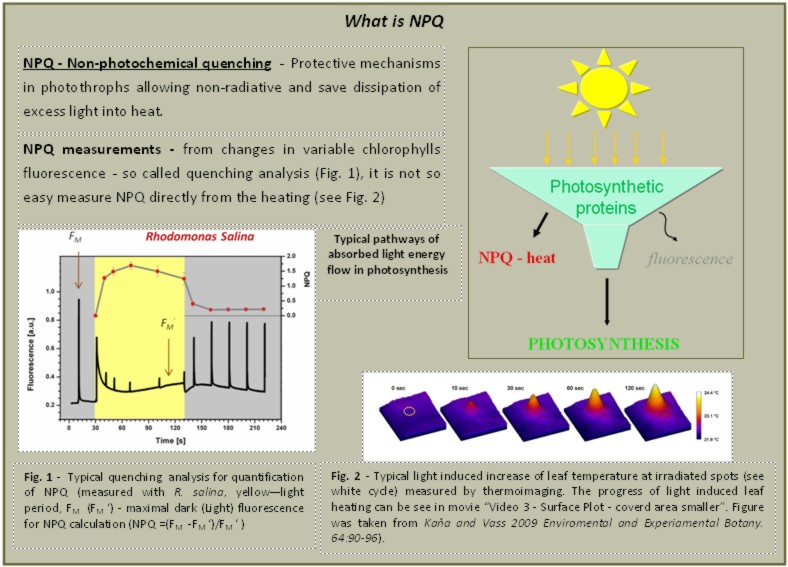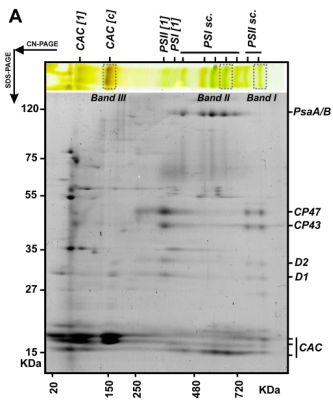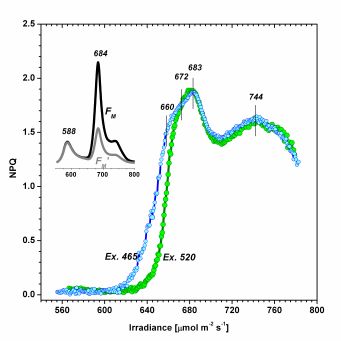Laboratoř fotosyntézy
Skupina Ondřeje Prášila
Mikrobiální fotosyntéza
Photoprotective mechanisms in algae
I'm intrerested in the mechanism of non-photochemical quenching (NPQ) in algae, with the main focuse on the red clade of photosythesis. Non-photochemical quenching represents an effective way how photosynthetic organisms can dissipate excessive irradiation into heat (see Kaňa et al. 2009). This process has been intensivelly studied in higher plants and green algae, however its mechanism in photothrophs from the red clade of photosynthesis is still rather questionable. Therefore, during last few years, I've focuded on the mechanism of NPQ in cryptophytes (see Kaňa et al. Plos ONE 2012 - pdf), red algae (Krupnik et al. JBC 2013 - pdf) and chromerids (Kotabová et al. FEBS lett. 2011) to explore photprotective pathways in these organisms in more details (see following sections).

Non-photochemical quenching in cryptohytes proceeds on antennae level
Photosynthesis uses light as a source of energy but its excess can result in production of harmful oxygen radicals. To avoid any resulting damage, phototrophic organisms can employ a process known as non-photochemical quenching (NPQ), where excess light energy is safely dissipated as heat. The mechanism(s) of NPQ vary among different phototrophs. Here, we describe a new type of NPQ in the organismRhodomonas salina, an alga belonging to the cryptophytes, part of the chromalveolate supergroup. Cryptophytes are exceptional among photosynthetic chromalveolates as they use both chlorophyll a/c proteins and phycobiliproteins for light harvesting.All our data demonstrates that NPQ in cryptophytes differs significantly from other chromalveolates – e.g. diatoms and it is also unique in comparison to NPQ in green algae and in higher plants: (1) there is no light induced xanthophyll cycle; (2) NPQ resembles the fast and flexible energetic quenching (qE) of higher plants, including its fast recovery; (3) a direct antennae protonation is involved in NPQ, similar to that found in higher plants. Further, fluorescence spectroscopy and biochemical characterization of isolated photosynthetic complexes suggest that NPQ in R. salinaoccurs in the chlorophyll a/c antennae but not in phycobiliproteins. All these results demonstrate that NPQ in cryptophytes represents a novel class of effective and flexible non-photochemical quenching (for details, see Kaňa et al. Plos ONE 2012 - pdf)


|
Protein compossition of thylakoid membrane of cryptophytes (R. salina). Note presense of antennae complex CACc, a locus of NPQ. |
Spectrally resolved NPQ shows NPQ in chlorophyll binding proteins, and no quenching of phycoerythrin fluorescence |
Reaction center type of quenching in red algae
Members of the rhodophytan orderCyanidialesare unique among phototrophs in their ability to live in extremely low pH levels and moderately high temperatures. The photosynthetic apparatus of the red algaCyanidioschyzon merolaerepresents an intermediate type between cyanobacteria and higher plants, suggesting that this alga may provide the evolutionary link between prokaryotic and eukaryotic phototrophs. Although we now have a detailed structural model of photosystem II (PSII) from cyanobacteria at an atomic resolution, no corresponding structure of the eukaryotic PSII complex has been published to date. Here we report the isolation and characterization of a highly active and robust dimeric PSII complex fromC. merolae. We show that this complex is highly stable across a range of extreme light, temperature, and pH conditions. By measuring fluorescence quenching properties of the isolated C. merolae PSII complex, we provide the first direct evidence of pH-dependent non-photochemical quenching in the red algal PSII reaction center. This type of quenching, together with high zeaxanthin content, appears to underlie photoprotection mechanisms that are efficiently employed by this robust natural water-splitting complex under excess irradiance (for details, see Krupnik et al. 2013 - pdf)
Fast violaxanthin deepoxidation in Chromera velia
Non-photochemical quenching (NPQ) is a mechanism protecting photosynthetic organisms against excessive irradiation. Here, we analyze a unique NPQ mechanism in the algaChromera velia,a recently discovered close relative of apicomplexan parasites. NPQ inC. veliais enabled by an operative and fast violaxanthin de-epoxidation to zeaxanthin without accumulation of antheraxanthin. InC. veliaviolaxanthin also serves as a main light-harvesting pigment. Therefore, in C. velia violaxanthin acts as a key factor in both light harvesting and photoprotection. This is in contrast to a similar alga, Nannochloropsis limnetica, where violaxanthin has only light-harvesting function.